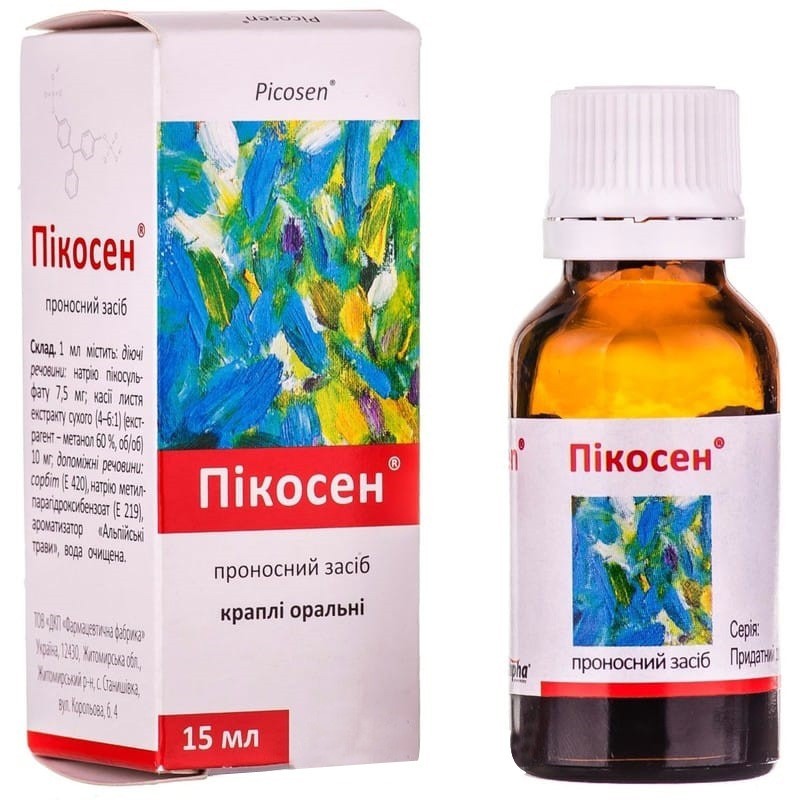



 Secure and encrypted payment processing
Secure and encrypted payment processing We ship to over 40 countries including the USA, UK, Europe, Australia and Japan
We ship to over 40 countries including the USA, UK, Europe, Australia and Japan Guaranteed refund or reship if you haven't received your order
Guaranteed refund or reship if you haven't received your orderpicosene is a combined contact laxative drug. sodium picosulfate is a laxative of local action of the triarylmethane group, which after bacterial cleavage in the colon stimulates its mucous membrane, improves peristalsis, contributing to an increase in the volume of water and electrolytes in the lumen of the colon. as a result: stimulation of defecation, reduction of passage time and softening of stool.
Senna antraglycosides slow down fluid absorption and stimulate intestinal wall motility.
Pharmacokinetics After using per os sodium, picosulfate reaches the colon without apparent absorption. The onset of action is 6-12 hours after the use of the drug, which is associated with the release of the active substance of the drug. After application, a small amount of the drug is determined in the organs and systems of the body.
Constipation or cases requiring relief of bowel movements.
Adults and children aged 12 years - 10-20 drops.
Picosen should be taken 1 r / day at night to empty the bowel the next morning.
The minimum effective dose necessary to restore normal bowel function should be taken.
Picosen should not be used daily or for a long period without determining the etiology of constipation.
Hypersensitivity to active substances, other representatives of the triarylmethane group or any of the excipients of the drug;
On the part of the immune system: hypersensitivity reaction, including angioedema, skin rash, urticaria, pruritus, local and generalized exanthema.
From the digestive system: digestive disorders, anorexia, discoloration of the urine, intestinal pseudomelanosis, disturbances of water-electrolyte balance (hypokalemia, hypocalcemia), albuminuria, hematuria, cramping and abdominal pain, diarrhea, flatulence, nausea, vomiting. Prolonged and excessive use of the drug can cause loss of fluid, potassium and other electrolytes. This, in turn, can lead to weakening of muscle and impaired cardiac function, especially in the case of combined use with diuretics or corticosteroids.
From the nervous system: dizziness; syncope. The likelihood of dizziness and fainting is associated with a vasovagal reaction (such as an abdominal spasm or bowel movement).
From the endocrine system: hyperaldosteronism.
Other: impaired cardiac activity, increased fatigue, fainting, drowsiness, muscle weakness, cramps.
In patients with chronic constipation, a complete diagnosis must be made and its etiology determined if it is unknown.
The drug is intended for occasional use.Long-term and excessive use can cause a violation of the water or electrolyte balance, hypokalemia and increased intestinal atony. There were reports of episodes of dizziness and / or fainting coinciding with sodium picosulfate. Existing information suggests that the above phenomena correspond to syncope during defecation (associated with a Valsalva test) or are associated with a vasovagal reaction to abdominal pain.
The drug contains sorbitol, so patients with rare hereditary fructose intolerance should not take it.
Use during pregnancy and lactation. There are no sufficient studies involving pregnant women. From a safety point of view, if possible, Picosen should not be used during pregnancy. It is recommended to stop breast-feeding during the period of the drug therapy, since the components of the drug can penetrate into breast milk and cause the appearance of frequent loose stools in the baby. However, with proper dosage, the occurrence of undesirable effects in the child is unlikely.
No fertility studies have been conducted.
Children. Do not prescribe the drug to children aged 12 years.
The ability to influence the reaction rate when driving vehicles and working with other mechanisms. Studies of the impact on the ability to drive vehicles and work with mechanisms have not been conducted. However, patients should be warned about the possibility of developing adverse reactions such as dizziness and / or fainting as a result of a vasovagal reaction (in particular, abdominal spasm). In the event of an abdominal cramp, the patient should avoid potential hazardous activities such as driving a vehicle and working with machinery.
The combined use of high doses of picosene and diuretics or corticosteroids may increase the risk of electrolyte imbalance, which can lead to increased sensitivity to cardiac glycosides. the simultaneous use of antibiotics can reduce the laxative effect of the drug.
May result in loose stools (diarrhea), intestinal cramps, and clinically significant loss of fluid, potassium, and other electrolytes.
In case of acute overdose, the consequences can be minimized or eliminated by forced vomiting or gastric lavage after a short period of time after taking Picosen. It may be necessary to compensate for the deficiency of fluid in the body and correct electrolyte balance. Antispasmodics can be used. Colon mucosal ischemia has been reported with high doses of sodium picosulfate, significantly higher than those usually recommended for constipation.
Picosene, like other laxatives, with prolonged overdose can lead to chronic diarrhea and abdominal pain, hypokalemia, secondary hyperaldosteronism and, possibly, the formation of kidney stones. With prolonged abuse of laxatives, damage to the renal tubules, metabolic alkalosis, myasthenia due to hypokalemia was reported.
At a temperature not exceeding 25 ° C.